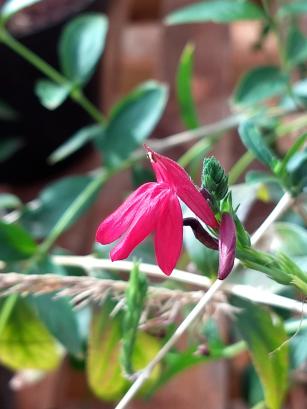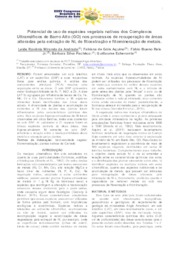The study identified 200 native Cerrado plants that can tolerate high levels of nickel in the soil. Nineteen species hyperaccumulate the metal and can help to remove nickel from the soil to decontaminate it (phytoremediation).. They can also can be a more affordable means to obtain metals of economic interest (phytomining). The species' potential was discovered during study in a mining region in Goiás state. Partnership with mining company is allowing the rehabilitation of an area with the use of regional species. Embrapa researchers have identified in the Cerrados of Goiás state 19 plant species with the capacity to absorb large amounts of nickel (Ni) and accumulate it in their leaves and stems. Recognized as nickel hyperaccumulators, their tissue can accumulate large amounts of the metal: more than 0.1% (or over 1,000 mg of Ni per kilo of dry matter). According to the Embrapa Cerrados researcher and project coordinator Leide Andrade, the species identified have potential to be used in the phytoremediation of soils contaminated by nickel in industrial or agricultural regions This process is simple the cultivation of plants that decontaminate soils with an excess of this chemical element as they accumulate it in their own parts. They can also be cultivated in previously mined soils that still contain nickel levels that the conventional mining process is not able to extract. Leide explains that these results are preliminary and that research must continue to better understand the action of this mechanism. The plants' potential was discovered when the study tried to identify species to be used to revegetate areas modified by mining in the ultramafic region of Barro Alto, GO, a place with important nickel deposits. The work resulted in the record of over 200 species that can grow in environments with high metal contents in the soil, i.e. nickel, magnesium, manganese, chromium, iron, cobalt, and others. The research was a responde to an enquiry by Anglo American mining company, which was seeking solutions to raise the standard of quality for the recovery of the environments left after nickel was mined and barren material (material removed from the mine to get to the ore, without economic value) was stacked. Current legislation requires such areas to be revegetated but does not define the type of plant cover that must be used. The company requested Embrapa to survey the local flora with the aim of assessing the impact of mining in plant diversity (vegetation suppression) and to define strategies for the revegetation of areas impacted by mining with the use of native species in the process. Out of the 200 species identified in the region of the study on tolerance to high metal levels in the soil, 29 were selected due to their abundance and capacity to colonize altered environments. These herbaceous and bushy species were used to compose a technological protocol to revegetate slopes composed of piles of barren material from nickel mining, which includes definitions of the period to harvest seeds, best sowing time and cultivation techniques. Understand phytoremediation and phytomining Native and tolerant species the rich environments in metals can be used in phytotechnological processes (or green technology) to stabilize areas degraded by mining activities (piles of barren rock, backfills, bottoms of digs, etc.). In the case of metal hyperaccumulator species, they can work in the process called phytoremediation, with which it is possible to “clean” the soil as the plants extract the elements that are present in excessive levels and accumulate them in their stem and leaf tissues. That can prevent environmental problems like the contamination of the groundwater and bodies of water, and allow other species to better develop in those areas. A second process that benefits from the use of hyperaccumulators is phytomining to obtain metals of economic interest (rare or precious ones, e.g. nickel) whose mining through conventional methods would be uneconomical. For nickel, cultivation is made in previously mined soils or ones with low metal content, but which still contain metal levels that are higher than unmineable soils, where the process of traditional mining would be uneconomical or impracticable through conventional methods. The substrata in the piles of barren material have little organic matter and low microbiological activity, and they are poor in important nutrients for plant development (read the box below). They also contain high levels of chromium in the CrVI form. “Such characteristics do not favor life and hinder spontaneous biological recovery in those environments”, the Embrapa researcher explains. On the other hand, the native vegetation that grows on ultramafic soils (from which Ni ore is extracted) is more adapted to this environment and thus presents higher tolerance to the presence of high metal levels in the soil. “By revegetating the piles of barren rock, it is possible to keep those species in the environment and reduce the impacts of mining in local biodiversity”, states the scientist. Ultramafic soils and piles of barren rock The soils in the Barro Alto region derive from ultramafic rocks and thus present high content of some metals like nickel, chromium, magnesium and cobalt, which, in high concentrations, can be toxic for most plants. Because of that, they have a differentiated chemical composition and present low levels of nutrients like phosphorus, potassium and calcium. Mining removes material composed by one or more minerals from the mine to clear the path to the ore, and it is later stacked into piles. They are materials with no economic value, but they can contain traces of a few metals, like chromium VI, and in higher concentrations than what is found in normal soils, and can contaminate underground waters. Such piles are generally revegetated with exotic species, which are mostly grasses and legumes. The study aimed to replace the use of such species with speciments of the plant diversity in the region due to their ability to stabilize areas degraded by mining. Photo: Leide Andrade Over 200 species catalogued The research entailed a multidisciplinary team comprising specialists in botanics and plant ecology, soil fertility and microbiology, and environmental ecotoxicology. The first stage surveyed the botanical diversity and the chemical and microbiological characteristics of the soils derived from ultramafic rocks before the start of mining activities in Barro Alto. The team identified 200 species growing in characteristically little acid soils, with excess content of a few metals and lacking certain nutrients that are essential for plant development, such as phosphorus and potassium. The researcher underscores that such characteristics are very distinct from those observed in acid and chemically poor soils in the Cerrado biome, often used in the agriculture developed in the Brazilian Midwest. During the botanical surveys, seeds of 106 species were collected, tested and studied on their germination, propagation and sowing. At a second stage, the research team selected 29 native plants that were cultivated on slopes made of piles of barren material in pilot experiments on the revegetation of those slopes. “The biggest challenge was to start off from a complete unfamiliarity with the environment and follow the beginning of the mining company's activities. We know that research takes longer time, but we needed to provide a response that could meet the critical challenges found there and equally meet the mining company's need”, Andrade reveals. A protocol to revegetate mining areas Based on information about the environment and respective flora, Embrapa developed a technological protocol, a type of guide, which indicates the stages required to revegetate nickel mining areas using species that are suited to soils with high metal levels. At the experimental stage, the species' seedlings and seeds were cultivated in the piles of barren material. In the selection, the researchers prioritized traits like habitus (whether they are grasses or shrubs, since planting trees is not recommended due to the instability of the slopes); fast growth and soil cover; early seed production; abiliity to establishment themselves in adverse environmental conditions e.g. soils that are rich in heavy metals. From then on, methodologies for the propagation of the selected species were developed. The ones that were sown directly in the substratum formed by the material removed from the mining area have the role of quickly covering the area. Meanwhile, the purpose of the seedlings is to create diversity in the systems, with plants of slower growth. “This strategy allows a process of succession of species with different ecological behaviors in the course of the time”, explains the researcher. The substratum was prepared with basic fertility correction, i.e. application of nitrogen, phosphorus and potassium, to make the environment more conducive to plant development. “The resulting substratum in the mining area took about six years to change from an almost exclusively mineral substratum into a soil that could stimulate and support plant growth. The plants slowly colonized the barren material and, through their roots, unchained biochemical changes like increases in organic matter and in microbiological activity, as well as a reduction in the availability of chromium VI, the most toxic form of the metal for the environment”, the specialist reports. Mining activities cause impact on the native vegetation. In addition, some plants cannot grow on the surfaces impacted, and the spontaneous regeneration processes present low plant diversity in comparison with the original diversity. The scientist reports that one of the aims of the study was to enable the use of the local flora to develop the technological protocol to revegetate areas impacted by mining. “It is like a puzzle. Each region is going to use species from their local biodiversity, but the steps established by the protocol could be followed anywhere”, she compares. That is because the revegetation of the piles of barren rock fully depends on the selection of adequate species and the use of efficient propagation techniques. It also aims at maximizing diversification with use of species with different ecological roles. Another result of the research is a phenologic calendar containing the period to collect the seeds of 106 native species in the ultramafic zone of Barro Alto, based on information about the beginning and the end of blooming and fruition of the species catalogued. The study recommends agronomic practices for cultivation and sources of nutrients for substrata and for the production of seeds and seedlings. It also created a database with over a thousand photos, which gathers the images captured during the several field visits that took place between 2008 and 2018. The research led by Embrapa concluded that the revegetation of areas impacted by mining through seeds and seedlings that are native to the region decreases the impact of the loss of local biological and genetic diversity. “The technological protocol is in process of validation on a field scale and could be applied on a large scale, using the species available in any region where native vegetation was completely eliminated. Hence it will be possible to make mining activities compatible with the conservation of the biodiversity in the areas explored”, states the researcher.
-
The study identified 200 native Cerrado plants that can tolerate high levels of nickel in the soil. -
Nineteen species hyperaccumulate the metal and can help to remove nickel from the soil to decontaminate it (phytoremediation).. -
They can also can be a more affordable means to obtain metals of economic interest (phytomining). -
The species' potential was discovered during study in a mining region in Goiás state. -
Partnership with mining company is allowing the rehabilitation of an area with the use of regional species. |
Embrapa researchers have identified in the Cerrados of Goiás state 19 plant species with the capacity to absorb large amounts of nickel (Ni) and accumulate it in their leaves and stems. Recognized as nickel hyperaccumulators, their tissue can accumulate large amounts of the metal: more than 0.1% (or over 1,000 mg of Ni per kilo of dry matter).
According to the Embrapa Cerrados researcher and project coordinator Leide Andrade, the species identified have potential to be used in the phytoremediation of soils contaminated by nickel in industrial or agricultural regions This process is simple the cultivation of plants that decontaminate soils with an excess of this chemical element as they accumulate it in their own parts.
They can also be cultivated in previously mined soils that still contain nickel levels that the conventional mining process is not able to extract. Leide explains that these results are preliminary and that research must continue to better understand the action of this mechanism.
The plants' potential was discovered when the study tried to identify species to be used to revegetate areas modified by mining in the ultramafic region of Barro Alto, GO, a place with important nickel deposits. The work resulted in the record of over 200 species that can grow in environments with high metal contents in the soil, i.e. nickel, magnesium, manganese, chromium, iron, cobalt, and others.

The research was a responde to an enquiry by Anglo American mining company, which was seeking solutions to raise the standard of quality for the recovery of the environments left after nickel was mined and barren material (material removed from the mine to get to the ore, without economic value) was stacked. Current legislation requires such areas to be revegetated but does not define the type of plant cover that must be used.
The company requested Embrapa to survey the local flora with the aim of assessing the impact of mining in plant diversity (vegetation suppression) and to define strategies for the revegetation of areas impacted by mining with the use of native species in the process.
Out of the 200 species identified in the region of the study on tolerance to high metal levels in the soil, 29 were selected due to their abundance and capacity to colonize altered environments. These herbaceous and bushy species were used to compose a technological protocol to revegetate slopes composed of piles of barren material from nickel mining, which includes definitions of the period to harvest seeds, best sowing time and cultivation techniques.
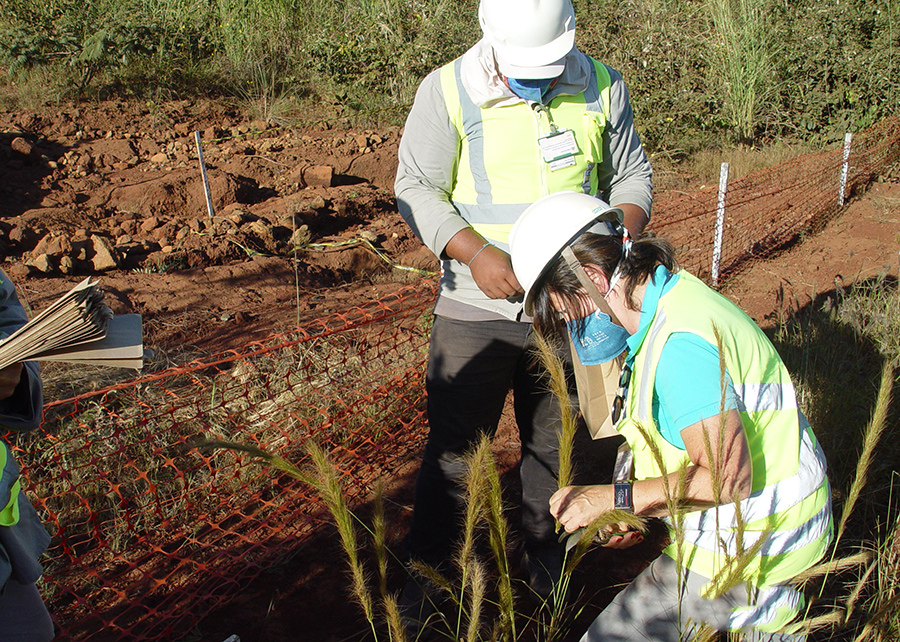 Understand phytoremediation and phytomining Understand phytoremediation and phytomining
Native and tolerant species the rich environments in metals can be used in phytotechnological processes (or green technology) to stabilize areas degraded by mining activities (piles of barren rock, backfills, bottoms of digs, etc.). In the case of metal hyperaccumulator species, they can work in the process called phytoremediation, with which it is possible to “clean” the soil as the plants extract the elements that are present in excessive levels and accumulate them in their stem and leaf tissues. That can prevent environmental problems like the contamination of the groundwater and bodies of water, and allow other species to better develop in those areas. A second process that benefits from the use of hyperaccumulators is phytomining to obtain metals of economic interest (rare or precious ones, e.g. nickel) whose mining through conventional methods would be uneconomical. For nickel, cultivation is made in previously mined soils or ones with low metal content, but which still contain metal levels that are higher than unmineable soils, where the process of traditional mining would be uneconomical or impracticable through conventional methods. |
The substrata in the piles of barren material have little organic matter and low microbiological activity, and they are poor in important nutrients for plant development (read the box below). They also contain high levels of chromium in the CrVI form. “Such characteristics do not favor life and hinder spontaneous biological recovery in those environments”, the Embrapa researcher explains. On the other hand, the native vegetation that grows on ultramafic soils (from which Ni ore is extracted) is more adapted to this environment and thus presents higher tolerance to the presence of high metal levels in the soil. “By revegetating the piles of barren rock, it is possible to keep those species in the environment and reduce the impacts of mining in local biodiversity”, states the scientist.

Ultramafic soils and piles of barren rock
The soils in the Barro Alto region derive from ultramafic rocks and thus present high content of some metals like nickel, chromium, magnesium and cobalt, which, in high concentrations, can be toxic for most plants. Because of that, they have a differentiated chemical composition and present low levels of nutrients like phosphorus, potassium and calcium.
Mining removes material composed by one or more minerals from the mine to clear the path to the ore, and it is later stacked into piles. They are materials with no economic value, but they can contain traces of a few metals, like chromium VI, and in higher concentrations than what is found in normal soils, and can contaminate underground waters.
Such piles are generally revegetated with exotic species, which are mostly grasses and legumes. The study aimed to replace the use of such species with speciments of the plant diversity in the region due to their ability to stabilize areas degraded by mining.
Photo: Leide Andrade
 Over 200 species catalogued
Over 200 species catalogued
The research entailed a multidisciplinary team comprising specialists in botanics and plant ecology, soil fertility and microbiology, and environmental ecotoxicology. The first stage surveyed the botanical diversity and the chemical and microbiological characteristics of the soils derived from ultramafic rocks before the start of mining activities in Barro Alto.
The team identified 200 species growing in characteristically little acid soils, with excess content of a few metals and lacking certain nutrients that are essential for plant development, such as phosphorus and potassium. The researcher underscores that such characteristics are very distinct from those observed in acid and chemically poor soils in the Cerrado biome, often used in the agriculture developed in the Brazilian Midwest.
During the botanical surveys, seeds of 106 species were collected, tested and studied on their germination, propagation and sowing. At a second stage, the research team selected 29 native plants that were cultivated on slopes made of piles of barren material in pilot experiments on the revegetation of those slopes.
“The biggest challenge was to start off from a complete unfamiliarity with the environment and follow the beginning of the mining company's activities. We know that research takes longer time, but we needed to provide a response that could meet the critical challenges found there and equally meet the mining company's need”, Andrade reveals.
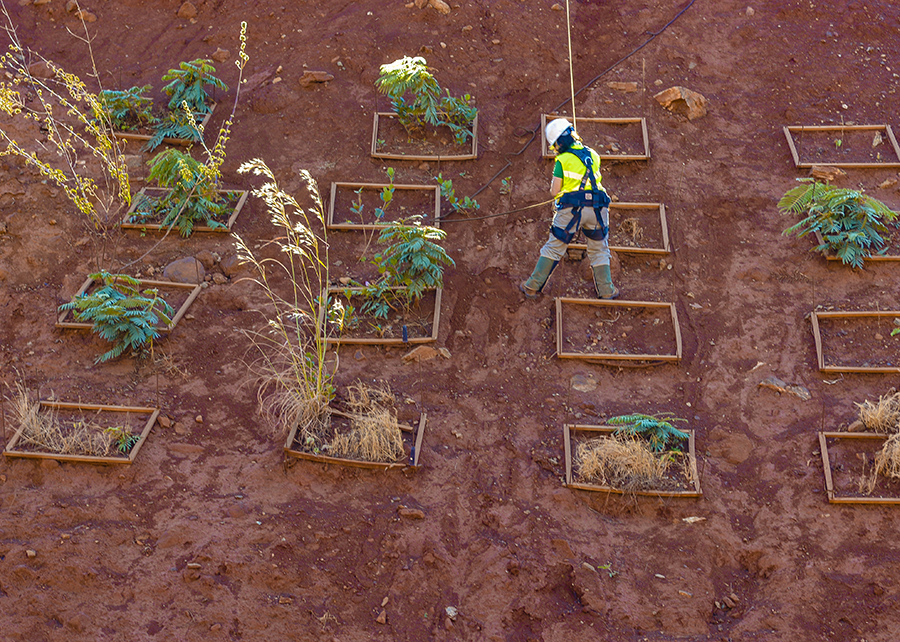
A protocol to revegetate mining areas
Based on information about the environment and respective flora, Embrapa developed a technological protocol, a type of guide, which indicates the stages required to revegetate nickel mining areas using species that are suited to soils with high metal levels.
At the experimental stage, the species' seedlings and seeds were cultivated in the piles of barren material. In the selection, the researchers prioritized traits like habitus (whether they are grasses or shrubs, since planting trees is not recommended due to the instability of the slopes); fast growth and soil cover; early seed production; abiliity to establishment themselves in adverse environmental conditions e.g. soils that are rich in heavy metals.
From then on, methodologies for the propagation of the selected species were developed. The ones that were sown directly in the substratum formed by the material removed from the mining area have the role of quickly covering the area. Meanwhile, the purpose of the seedlings is to create diversity in the systems, with plants of slower growth.
“This strategy allows a process of succession of species with different ecological behaviors in the course of the time”, explains the researcher. The substratum was prepared with basic fertility correction, i.e. application of nitrogen, phosphorus and potassium, to make the environment more conducive to plant development.
“The resulting substratum in the mining area took about six years to change from an almost exclusively mineral substratum into a soil that could stimulate and support plant growth. The plants slowly colonized the barren material and, through their roots, unchained biochemical changes like increases in organic matter and in microbiological activity, as well as a reduction in the availability of chromium VI, the most toxic form of the metal for the environment”, the specialist reports.
Mining activities cause impact on the native vegetation. In addition, some plants cannot grow on the surfaces impacted, and the spontaneous regeneration processes present low plant diversity in comparison with the original diversity. The scientist reports that one of the aims of the study was to enable the use of the local flora to develop the technological protocol to revegetate areas impacted by mining. “It is like a puzzle. Each region is going to use species from their local biodiversity, but the steps established by the protocol could be followed anywhere”, she compares. That is because the revegetation of the piles of barren rock fully depends on the selection of adequate species and the use of efficient propagation techniques. It also aims at maximizing diversification with use of species with different ecological roles.
Another result of the research is a phenologic calendar containing the period to collect the seeds of 106 native species in the ultramafic zone of Barro Alto, based on information about the beginning and the end of blooming and fruition of the species catalogued.
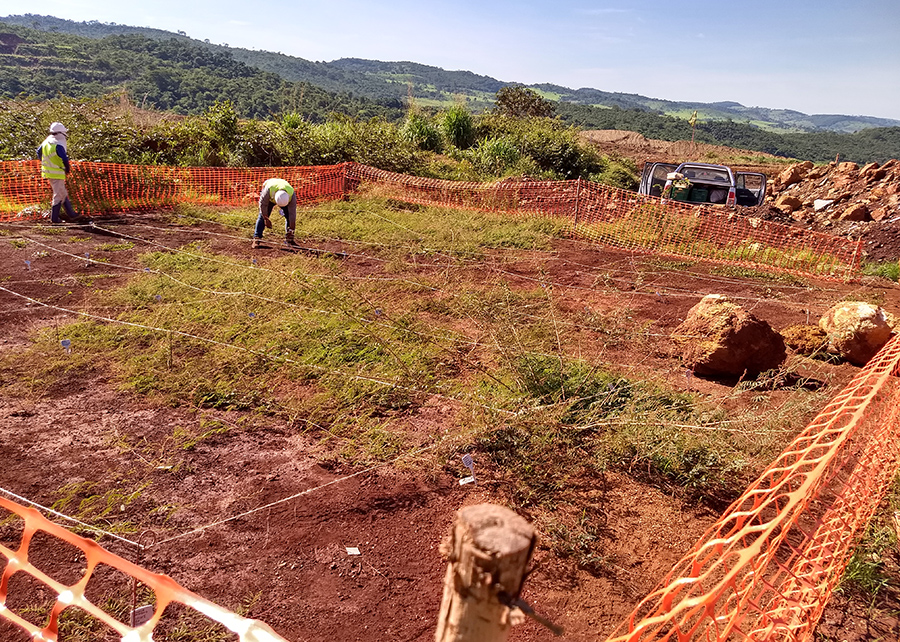 The study recommends agronomic practices for cultivation and sources of nutrients for substrata and for the production of seeds and seedlings. It also created a database with over a thousand photos, which gathers the images captured during the several field visits that took place between 2008 and 2018.
The study recommends agronomic practices for cultivation and sources of nutrients for substrata and for the production of seeds and seedlings. It also created a database with over a thousand photos, which gathers the images captured during the several field visits that took place between 2008 and 2018.
The research led by Embrapa concluded that the revegetation of areas impacted by mining through seeds and seedlings that are native to the region decreases the impact of the loss of local biological and genetic diversity. “The technological protocol is in process of validation on a field scale and could be applied on a large scale, using the species available in any region where native vegetation was completely eliminated. Hence it will be possible to make mining activities compatible with the conservation of the biodiversity in the areas explored”, states the researcher.
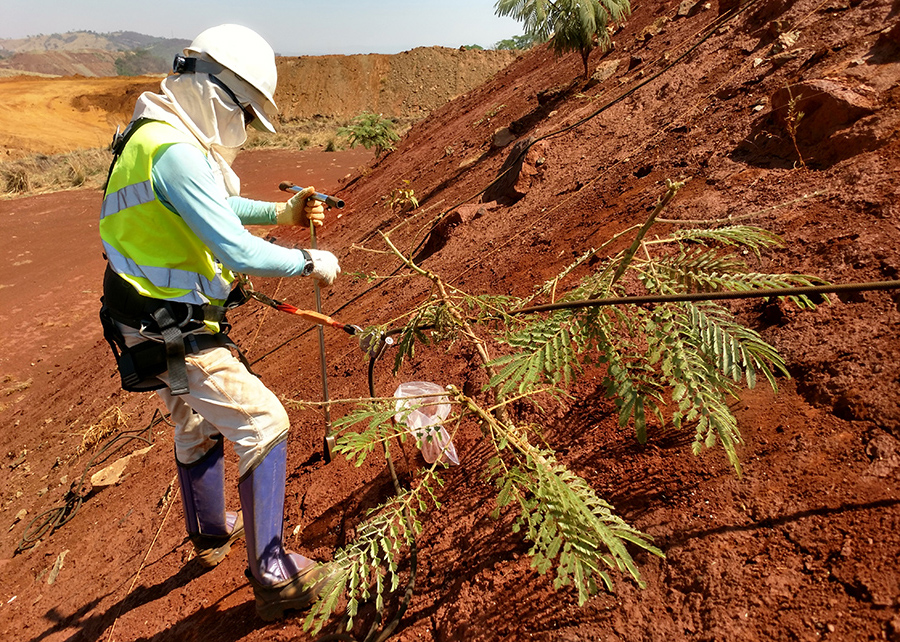
The study recommends agronomic practices for cultivation and sources of nutrients for substrata and for the production of seeds and seedlings. It also created a database with over a thousand photos, which gathers the images captured during the several field visits that took place between 2008 and 2018.

